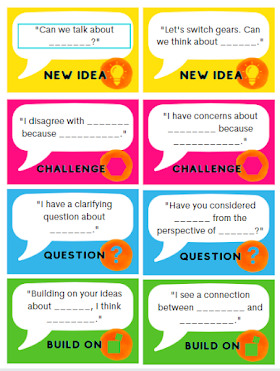Using Discussion Cards
Ever noticed, during group discussions, that students are really good at sharing their opinion, but then it's a massive struggle to build the conversation from there? I've slowly discovered that we have to teach students about the RANGE of ways they can contribute to a discussion.
For example, during a conversation, participants can add to the discussion in any of these ways:
- Add a new idea
- Challenge or disagree with what's been said
- Ask a clarifying question
- Build on someone else's idea
- Offer evidence to support an idea or a challenge
To support this, I created a "card game."
Here's what all 14 cards look like:
Here are the basic rules we've used to play -- but feel free to change them up. We also let the kids play rounds where they made up their own rules - this was successful, too!
If you're looking for a video version of the rules, watch this TikTok.
Number of Players:
- This works best with teams of 4, but will also work with 3-5 players.
Materials needed for play:
- Set of discussion cards (print a PDF copy here). You'll need one set of cards for each group. Print copies, then cut.
- 5-10 teacher-generated or student-generated discussion prompts
- A countdown timer (digital timers are fine)
The goal of the game:
- The team tries to play as many discussion cards as they can before time runs out.
The rules, round 1:
1) A discussion prompt is posted or shared (these can be teacher or student-generated). For example, "In The Poet X, Xiomara's Mom fails her daughter."
2) Shuffle the deck of cards, and deal an even number to everyone in the group. Leftover cards go in the middle of the table, face up. (In a group of 4, for example, everyone will have three cards, and then there will 2 cards face up in the middle).
3) The teacher sets a timer - 5 minutes is a good place to start. The youngest person in the group begins. They start the discussion by playing any one of their cards. When they play the card, they have to use the sentence stem written on that card to respond to the discussion prompt. After they've played the card, they place it face down in the discard pile.
4) Now that the conversation has started, players can go in any order. When a player has a discussion card that fits, they play it by using the discussion stem listed on the card to contribute to the conversation. Players may also play any of the leftover cards sitting in the center of the table.
5) Players continue playing their cards and using the discussion stems to contribute to the conversation until time runs out.
Scoring Points:
- At the end of each timed round, the team gets 1 point for every card that was successfully played.
Successive Rounds:
1) A new discussion prompt is shared. The team with the lowest number of total points gets to pick the prompt from a list of options.
2) Play occurs in the same way as the initial round.
Winning the Game:
- At the conclusion of all rounds, the team with the most total points wins.
As always, I'm thankful for collaborative partners that are willing to try all these new things with me!






Comments
Post a Comment